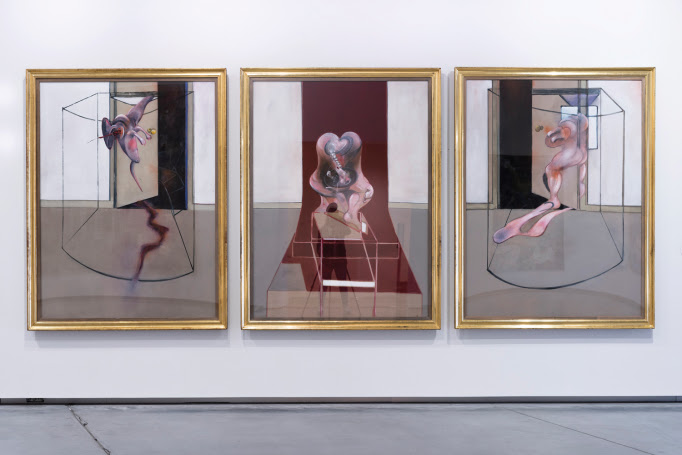Which Top 200 Collectors Can Spend $50 M. or More on a Single Purchase?
Impeccable Provenance: Francis Bacon, Triptych Inspired by the Oresteia of Aeschylus, 1981.
COURTESY ASTRUP FEARNLEY MUSEUM OF MODERN ART, OSLO.
“Nearly every season there is a new buyer at the top of the market,” says one of the auction house specialists whose job it is to line up bidders for the biggest-ticket lots. How big is big ticket? Let’s draw a somewhat arbitrary line at $50 million or more. These high eight- and nine-figure lots do more than just achieve the best price for consignors. As high-profile, headline-grabbing sales, they are also visible marketing for the very concept of high-value art. The world’s wealthiest collectors may value discreet transactions that very few people ever learn about until years later, but private sales don’t attract the attention of the random rich quite the way the public spectacle of an auction does.
With so much on the line for the auction house—and the art market—it should not come as a surprise to anyone that there is a lot of behind-the-scenes choreography every time a major lot comes up for sale. Finding a good bidder and a dance partner for that bidder—it takes two bidders to make a headline—is generally an exercise in polling the usual suspects: Alice Walton, Leon Black, Kenneth C. Griffin, David Geffen, Steven A. Cohen.
This year, however, as the pandemic wreaks major upheaval worldwide, the art market isn’t operating under business-as-usual rules. New buyers continue to enter the market, often at the very top. In June, Sotheby’s sold a Francis Bacon triptych with impeccable provenance for $84.6 million (with fees). The lot’s winner was on the other end of the telephone with Sotheby’s rainmaker Gregoire Billault, while the underbidder connected online from Hong Kong, and starting at $61.1 million, pursued the work all the way up to $73.1 million. Other auction insiders report seeing big bids come in online from new collectors in Switzerland and Turkey during this summer’s hybrid sales. Even the veterans don’t have a good answer for that one.
Insiders also wonder whether the new Sotheby’s owner, Patrick Drahi, has become a major art buyer. Drahi was a collector, mostly of Impressionist and modern art, and a client of Sotheby’s for some time before he bought the firm. But he has not previously been known as the kind of deep-pocketed spender who makes marquee purchases. Add to that Drahi’s well-known skill for using debt to make acquisitions. These are all good reasons to view the gossip with skepticism. But the thinking, which does have its own compelling logic based on the house’s behavior around guarantees, is that, like Christie’s owner, François Pinault, Drahi has incentives to buy from his own at the top of the market. He gets first pick of great works and helps market his own asset, Sotheby’s.
What provokes a billionaire to suddenly start buying art? Late last year, the world’s richest man, Amazon founder and CEO Jeff Bezos, entered the art market when he bought Ed Ruscha’s Hurting the Word Radio #2 for $52.5 million and Kerry James Marshall’s Vignette 19 for another $18.5 million in the same season. By several accounts, he hasn’t stopped there. Some of the super wealthy start buying, take a pause, and then return to the market. That’s what the specialists say about Yusaku Maezawa, who set several records with purchases at auction of Jean-Michel Basquiat’s work and private purchases of Mark Grotjahn’s work but pulled back as his Japanese fashion retailer, Zozo, struggled. In late 2019, Maezawa sold most of his stake in Zozo, for $2.3 billion, and his appetite for art has returned. Though he has not been fingered as the buyer of any of 2020’s major lots, he has been seen considering works with estimates around $20 million.
Whether a buyer from the ranks of the newly rich or a billionaire of long standing who finally joins the hunt, like Bezos and Drahi, or a client who consistently reemerges every few years after a period of dormancy, like Maezawa or Hasso Plattner, this kind of buying activity explains why the auction houses continue to pursue the often high-risk, low-return strategy of blockbuster sales. It’s the kind of marketing that slick videos and weighty catalogues cannot generate. The auction market is one of the few where a big sale itself is marketing for the very value of art. What’s kept the art market going these several years long after many thought it would have retreated to former levels is the influx of new, often unknown, buyers. “Every season,” says one rainmaker whose professional life depends on the health of the art market, “there is someone you just don’t expect.”
The List:
1. Jeff Bezos, Seattle
2. Kenneth C. Griffin, Chicago
3. Pierre Chen, Taipei
4. Alexandra and Steven A. Cohen, Greenwich, Connecticut
5. Sabine and Hasso Plattner, Heidelberg, Germany
6. Debra and Leon Black, New York
7. Yusaku Maezawa, Chiba City, Japan
8. Janine and J. Tomilson Hill, New York
9. Alice Walton, Fort Worth, Texas
10. Cecilia and Chung-Kiu “C.K.” Cheung, Hong Kong
11. Patrick Drahi, Switzerland
12. Wang Wei and Liu Yiqian, Shanghai
13. David Geffen, Los Angeles
14. François Pinault, Paris
15. (tied) Roman Abramovich, Moscow; New York; London
15. (tied) Dasha Zhukova, Moscow; New York; Los Angeles
